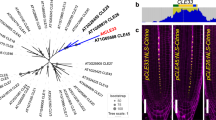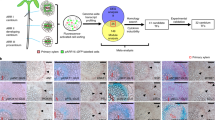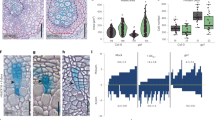Abstract
Vascular plants have a long-distance transport system consisting of two tissue types with elongated cell files, phloem and xylem1. Phloem has two basic cell types, enucleate sieve elements and companion cells. Xylem has various lignified cell types, such as tracheary elements, the differentiation of which involves deposition of elaborate cell wall thickenings and programmed cell death1,2,3,4. Until now, little has been known about the genetic control of phloem–xylem patterning. Here we identify the ALTERED PHLOEM DEVELOPMENT (APL) gene, which encodes a MYB coiled-coil-type transcription factor that is required for phloem identity in Arabidopsis. Phloem is established through asymmetric cell divisions and subsequent differentiation. We show that both processes are impaired by a recessive apl mutation. This is associated with the formation of cells that have xylem characteristics in the position of phloem. The APL expression profile is consistent with a key role in phloem development. Ectopic APL expression in the vascular bundle inhibits xylem development. Our studies suggest that APL has a dual role both in promoting phloem differentiation and in repressing xylem differentiation during vascular development.
This is a preview of subscription content, access via your institution
Access options
Subscribe to this journal
Receive 51 print issues and online access
$199.00 per year
only $3.90 per issue
Buy this article
- Purchase on Springer Link
- Instant access to full article PDF
Prices may be subject to local taxes which are calculated during checkout




Similar content being viewed by others
References
Esau, K. Anatomy of Seed Plants 2nd edn (John Wiley & Sons, New York, 1977)
Oparka, K. J. & Turgeon, R. Sieve elements and companion cells—traffic control centers of the phloem. Plant Cell 11, 739–750 (1999)
Kuhn, C. et al. Macromolecular trafficking indicated by localization and turnover of sucrose transporters in enucleate sieve elements. Science 275, 1298–1300 (1997)
Ye, Z. H. Vascular tissue differentiation and pattern formation in plants. Annu. Rev. Plant Biol. 53, 183–202 (2002)
McConnell, J. R. & Barton, M. K. Leaf polarity and meristem formation in Arabidopsis. Development 125, 2935–2942 (1998)
Waites, R. & Hudson, A. phantastica: a gene required for dorsiventrality of leaves in Antirrhinum majus. Development 121, 2143–2154 (1995)
Aloni, R. Differentiation of vascular tissues. Annu. Rev. Plant Physiol. 38, 179–204 (1987)
Carland, F. M. et al. Genetic regulation of vascular tissue patterning in Arabidopsis. Plant Cell 11, 2123–2137 (1999)
Mahonen, A. P. et al. A novel two-component hybrid molecule regulates vascular morphogenesis of the Arabidopsis root. Genes Dev. 14, 2938–2943 (2000)
Baum, S. F., Dubrovsky, J. G. & Rost, T. L. Apical organization and maturation of the cortex and vascular cylinder in Arabidopsis thaliana (Brassicaceae) roots. Am. J. Bot. 89, 908–920 (2002)
Imlau, A., Truernit, E. & Sauer, N. Cell-to-cell and long-distance trafficking of the green fluorescent protein in the phloem and symplastic unloading of the protein into sink tissues. Plant Cell 11, 309–322 (1999)
Torres-Ruiz, R. A. & Jurgens, G. Mutations in the FASS gene uncouple pattern formation and morphogenesis in Arabidopsis development. Development 120, 2967–2978 (1994)
Scheres, B. et al. Mutations affecting the radial organisation of the Arabidopsis root display specific defects throughout the embryonic axis. Development 121, 53–62 (1995)
Rubio, V. et al. A conserved MYB transcription factor involved in phosphate starvation signaling both in vascular plants and in unicellular algae. Genes Dev. 15, 2122–2133 (2001)
Scheres, B. et al. Embryonic origin of the Arabidopsis primary root and root meristem initials. Development 120, 2475–2487 (1994)
Di Laurenzio, L. et al. The SCARECROW gene regulates an asymmetric cell division that is essential for generating the radial organization of the Arabidopsis root. Cell 86, 423–433 (1996)
Helariutta, Y. et al. SHORT-ROOT gene controls radial patterning of the Arabidopsis root through radial signaling. Cell 101, 555–567 (2000)
Lin, Y. & Schiefelbein, J. Embryonic control of epidermal cell patterning in the root and hypocotyl of Arabidopsis. Development 128, 3697–3705 (2001)
Inoue, T. et al. Identification of CRE1 as a cytokinin receptor from Arabidopsis. Nature 409, 1060–1063 (2001)
Suzuki, T. et al. The Arabidopsis sensor His-kinase, AHK4, can respond to cytokinins. Plant Cell Physiol. 42, 107–113 (2001)
Lawson, N. D. et al. Notch signaling is required for arterial–venous differentiation during embryonic vascular development. Development 128, 3675–3683 (2001)
Lawson, N. D. & Weinstein, B. M. Arteries and veins: making a difference with zebrafish. Nature Rev. Genet. 3, 674–682 (2002)
Yoshimura, T., Demura, T., Igarashi, M. & Fukuda, H. Differential expression of three genes for different β-tubulin isotypes during the initial culture of Zinnia mesophyll cells that divide and differentiate into tracheary elements. Plant Cell Physiol. 37, 1167–1176 (1996)
McCann, M. Tracheary element formation: building up to a dead end. Trends Plant Sci. 2, 333–338 (1997)
Wisman, E., Cardon, G. H., Fransz, P. & Saedler, H. The behaviour of the autonomous maize transposable element En/Spm in Arabidopsis thaliana allows efficient mutagenesis. Plant Mol. Biol. 37, 989–999 (1998)
Liu, Y. G. et al. Complementation of plant mutants with large genomic DNA fragments by a transformation-competent artificial chromosome vector accelerates positional cloning. Proc. Natl Acad. Sci. USA 96, 6535–6540 (1999)
Acknowledgements
We thank M. Kivimäki, K. Kainulainen, A. Hakonen, J. Immanen, Q. Yu, F. D. Rodriguez, G. Resch and M. Ilijin-Jug for technical assistance and plant cultivation; E. Jokitalo for TEM; M. Laxell and S. Tähtiharju for material; I. Bancroft and K. van de Sande at GARNet/GeTCID; N. Sauer for the AtSUC2::GFP line; E. Mellerowicz, F. Rook and M. Saarma for advice; and P. N. Benfey, B. Scheres and C. Alonso Blanco for comments on the manuscript. Financial support was provided by the Academy of Finland, Tekes, EU, EMBO and the University of Helsinki.
Author information
Authors and Affiliations
Corresponding author
Ethics declarations
Competing interests
The authors declare that they have no competing financial interests.
Rights and permissions
About this article
Cite this article
Bonke, M., Thitamadee, S., Mähönen, A. et al. APL regulates vascular tissue identity in Arabidopsis. Nature 426, 181–186 (2003). https://doi.org/10.1038/nature02100
Received:
Accepted:
Issue Date:
DOI: https://doi.org/10.1038/nature02100
This article is cited by
-
Role of GARP family transcription factors in the regulatory network for nitrogen and phosphorus acquisition
Journal of Plant Research (2024)
-
Asymmetric gene expression and cell-type-specific regulatory networks in the root of bread wheat revealed by single-cell multiomics analysis
Genome Biology (2023)
-
How to explore what is hidden? A review of techniques for vascular tissue expression profile analysis
Plant Methods (2023)
-
OBERON3 and SUPPRESSOR OF MAX2 1-LIKE proteins form a regulatory module driving phloem development
Nature Communications (2023)
-
A phosphoinositide hub connects CLE peptide signaling and polar auxin efflux regulation
Nature Communications (2023)
Comments
By submitting a comment you agree to abide by our Terms and Community Guidelines. If you find something abusive or that does not comply with our terms or guidelines please flag it as inappropriate.



